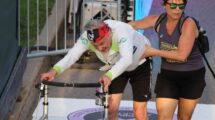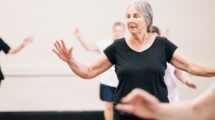We often hear the word “balance” and think of the seemingly impossible goal of achieving that smooth transition between work, home, family, fitness, healthy eating, and so on (good luck with that!). But equally important is the simple ability to stand on your own two feet. Many of my senior yoga students have told me that the most significant benefit they’ve received from the consistent practice of yoga is the massive amount of confidence that comes with feeling steady. They’ve taken up (or returned to after a period away!) skating on the canal with their grandchildren and other activities that they’d either stopped or not even considered.
Our balance can start to decline as early as age 50 and steadily so from there. This is a big deal because as we move into our 60s, compromised balance is a primary cause of falls; falls account for a large percentage of hospital admissions, and the aftermath of a fall can significantly impact our quality of life thenceforth. Even a fairly common injury for all ages, like a pulled hamstring or twisted ankle, can take months to recover from, let alone a broken hip! Research shows that our balance does suffer to some degree in the natural process of aging, but there are things we can do to stop the momentum and even reverse the loss already incurred.
Not Just an Old Folk’s Issue!
A close relative of balance is dizziness. An extensive epidemiological study stated that “as many as 35% of adults aged 40 years or older in the United States—approximately 69 million Americans—have experienced some form of vestibular dysfunction.1 (Arch Intern Med 2009;169:938-44.) Although the causes underlying a vestibular disorder, like vertigo, are likely very different, they both share the common frustration of feeling unsteady.
Get Vertical to Ease Vertigo
Do you remember partying a little too hard in college and, the next morning, putting your foot on the floor to “stop the room from spinning”? Unlike someone having a dizzy spell or experiencing post-party repercussions, people who suffer from vertigo have the sensation of spinning or floating, but without the wild night before. It’s about as far from a party as you can get!
Studies have shown that placing the head in a specific position can help dislodge crystals of the inner ear canal which can contribute to dizziness. You’re best to consult your doctor on that. But in the meantime, there are ways to ease the dizzying and disconcerting effects of the condition.
The grounding effects of postures such as Paschimottanansa and Balasana (Child’s Pose) can help calm the mind and ease feelings of dizziness. An anonymous Iyengar Yoga teacher published an article on vertigo, recommending that, “If you’re experiencing spinning sensations, mentally focusing on those body parts that are in touch with the earth can dramatically reduce the length of the spinning and the associated anxiety.”
You can find the full article here.
In Child’s Pose, press the tops of your feet into the floor; in Paschimottanasana root down through the sitting bones and press your calves and heels in the earth.
Many people have noticed that stress contributes to their vertigo. If you’ve found the same, make Savasana (or Legs-Up-the-Wall Pose) part of your daily routine. For best effect, cover your eyes with a heavy cloth to allow them to rest deeply.
Eryn Kirkwood is a local author and yoga teacher who specializes in classes for students aged 55 years and older. She offers a full schedule of classes at Barrhaven United Church in Nepean, along with workshops and other offerings! See ErynsYoga.com for more information.
This article is not intended to diagnose any issues or to impart medical or therapeutic advice! It is always best to consult with a doctor before initiating these or any other exercise programs relating to your condition. This article was previously published in Sweat Equity







